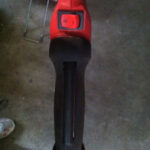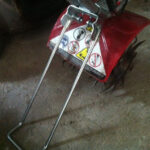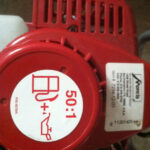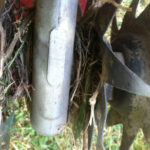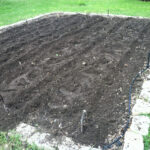
Preparing your soil for seeds or plants by tilling it or mixing it can really help your plants get established. Plants and seeds put out roots to gather nutrients and water, and tilled soil makes it easier for the roots to penetrate. Manually mixing soil is very hard, so we opted for a tiller.
Mantis Tiller Review
The tiller we have is a Mantis Deluxe 2-Cycle Tiller. It’s pretty small, weighing it about 25 pounds, and the tiller is only 9 inches wide.
Pros
- Lightweight
- Easy to transport
- Kickstand to support tiller when not in use
- Small enough to fit into tight spaces around plants
- Easier to maneuver than large tillers
- Handles in front to make it easier to carry
- Height of handles can be adjusted
- Lifetime guarantee on tines
- Powerful enough for soil with small-to fair amounts of clay and small tree roots

We share this small tiller with my folks, so the ease of transport is a great thing. The handles can be folded down, making it fit easily in my hatchback or a trunk. The previous tiller we shared was a monster, requiring a truck or a trailer to move it.
Cons
- Sometimes hard to start
- Doesn’t work well for really compact soil or soil with lots of clay
- Very bouncy in compact soil or when meeting resistance (lots of roots, rocks)
- Lot of vibration in the handles
- Can be hard to control when bouncing
The problems with getting this machine to start may all lie in the quality of the gas and how long the machine has been in storage. It requires a blend of oil and gas. The manual recommends only mixing enough that can be used in one month’s time. Thus, if your tiller sits around for a couple of weeks, the gas mixture may have decomposed too much to use, causing it to be difficult to start and run. We are not religious about keeping fresh gas in the machine, and that is probably the problem.
Despite the problems with starting the tiller, I think it’s a pretty good one for our purposes. I use it to till up the soil in my raised beds when the tree roots are getting kind of thick. I also use it to till an in-ground bed that we have worked for several years already. It does a good job in both, though it takes some time to get deep into the soil. And I never seem to get the 10 inches of depth that the brand claims, but maybe I am just not patient enough. However, if you need a heavier machine to start a garden where there was none and your soil is very compact or full of clay and rocks, this may not be the machine for you. Or if you have difficulty with controlling a bouncing machine, this isn’t the tiller for you either. See the video below for an example of the bouncing.
How to Start the Mantis Tiller
The steps for starting the tiller are easy, and, in general, work well. First, tun the switch (button) on the handle to on (the dash symbol is on, the open circle is off). Then prime the gas bubble 4-5 times until there is visible gas in the bubble. Pull the choke lever up, then pull the starter cord. Once started, put the choke lever down. Pull up on the button under the handle (grip it) to start the tines.
Read and Use the Manual
I know, this seems like an easy one, but how many of us actually read manuals now adays? To keep the tiller working well and for some helpful tips on using the tiller and maintaining the tiller, read the manual. The manual for the 2-cycle deluxe is available here: http://mantis.com/global/assets/owners_manuals/deluxe-tillers/401775%20Mantis%20Deluxe%202C-4C%20tiller%20manual.pdf
Tips
- If you get a lot of roots or weeds wrapped around the tines, it is worth the time to stop and remove them. This will help the motor and make your tilling go better.
- Wear gloves if using the tiller for a long period of time. The vibration in the handles can irritate your skin and the gloves will give you a better grip too.
- Make sure the handles are adjusted to fit your height. You’ll be more comfortable and you can control the tiller better.
- Read the manual for some times on best ways to use the tiller in more compact soils.
- Go a bit slower to reduce the bouncing
[GARD]

